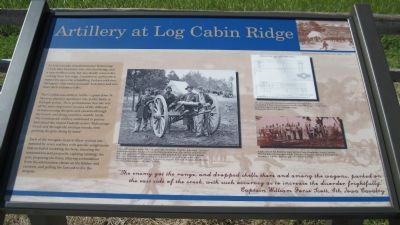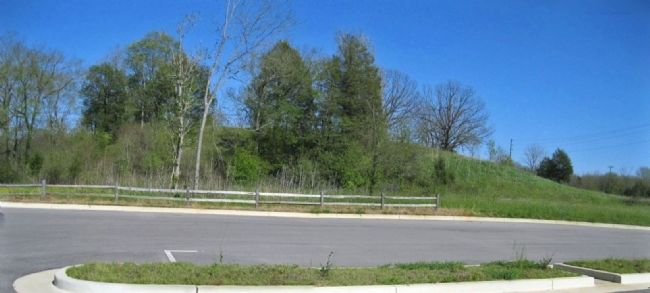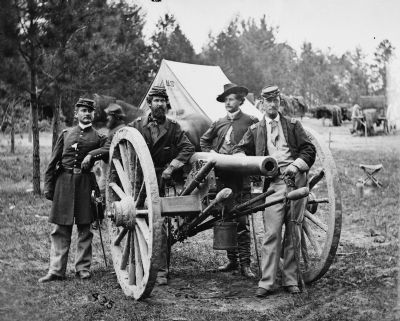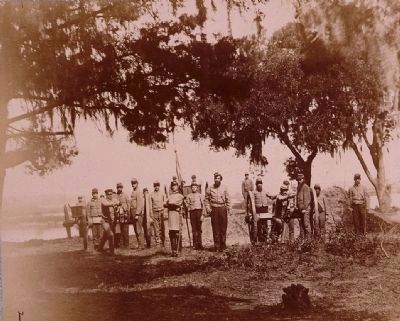Near Baldwyn in Prentiss County, Mississippi — The American South (East South Central)
Artillery at Log Cabin Ridge
The Confederate artillery, led by Captain John W. Morton, played a significant role in this battle at multiple points. Their performance that day was all the more impressive because of the difficulty of maneuvering the guns and caissons through the woods and along primitive, muddy roads. The Confederate artillery continued to pursue and attack the routed Federals across Tishomingo Creek and through the swampy woods, even pushing the guns along by hand.
Each of the two guns in an artillery section was manned by seven soldiers with specific assignments that included swabbing the bore, inserting the ammunition and projectile, sighting (aiming) the gun, preparing the fuses, relaying ammunition from the ammunition chests on the limber and caissons, and pulling the lanyard to fire the weapon.
"The enemy got the range, and dropped shells there and among the wagons, parked on the east side of the creek, with such accuracy as to increase the disorder frightfully" —Captain William Forse Scott, 4th Iowa Cavalry
Topics. This historical marker is listed in this topic list: War, US Civil.
Location. 34° 30.691′ N, 88° 43.906′ W. Marker is near Baldwyn, Mississippi, in Prentiss County. Marker can be reached from State Highway 370, 0.4 miles west of Bethany Road (State Highway 370), on the right when traveling west. The Tishomingo Overlook Road is a short park road that ends at a parking area and overlook (Auto Tour Stop 7). The marker is at the parking area. Touch for map. Marker is in this post office area: Baldwyn MS 38824, United States of America. Touch for directions.
Other nearby markers. At least 8 other markers are within walking distance of this marker. Terrain and Landscape (a few steps from this marker); Brice's Cross Roads (within shouting distance of this marker); Union Wagon Train (within shouting distance of this marker); a different marker also named Brice's Cross Roads (about 300 feet away, measured in a direct line); General Barteau's Flank Movement (about 400 feet away); Tishomingo Creek Bridge (about 400 feet away); Chief Tishomingo (about 500 feet away); a different marker also named Tishomingo Creek Bridge (about 500 feet away). Touch for a list and map of all markers in Baldwyn.
More about this marker. The marker contains the following photographs and drawings:
Center Photograph: Union
officers with three-inch ordnance rifle, Fair Oaks, Virginia, June 1862. The three-inch ordnance rifle was named for the diameter of its bore (the interior of the barrel). It fired elongated solid projectiles, and its rifled (grooved) bore gave the gun greater accuracy. At the maximum elevation, it could launch projectiles up to one mile. Photographed by James F. Gibson. — Library of Congress, Prints & Photographs Division, Civil War Photographs. (LC-B8171-0435)
Top Right Corner Drawing: Jackson in check at White Oak Creek — Harper's Weekly
Top Right Technical Drawing: "Field 12 Pounder Howitzer - Bronze" - The twelve pounder howitzer is named for the weight of the solid iron cannonballs it fired. Howitzers were usually smoothbore guns designed for launching large projectiles at shorter ranges.
Bottom Right Photograph: A gun crew of the Palmetto Light Artillery near Charleston, South Carolina. Photographed by George S. Cook. — Library of Congress, Prints & Photographs Division, Civil War Photographs. (LC-USZC4-4606)
Also see . . . Brices Cross Roads National Battlefield Site. National Park Service (Submitted on March 7, 2014.)
Credits. This page was last revised on June 16, 2016. It was originally submitted on March 7, 2014, by David Graff of Halifax, Nova Scotia. This page has been viewed 748 times since then and 20 times this year. Photos: 1, 2. submitted on March 7, 2014, by David Graff of Halifax, Nova Scotia. 3, 4. submitted on March 7, 2014. • Bernard Fisher was the editor who published this page.



